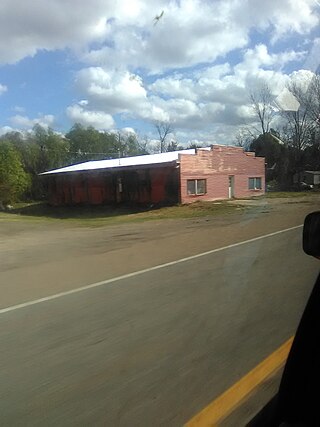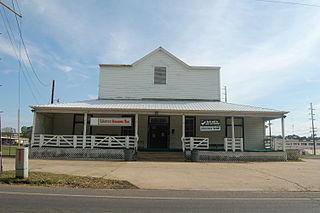
Natchitoches Parish is a parish located in the U.S. state of Louisiana. As of the 2020 census, the population was 37,515. The parish seat and most populous municipality is Natchitoches, the largest by land area is Ashland, and the most densely populated area is Campti. The parish was formed in 1805.

Natchez is a village in Natchitoches Parish, Louisiana, United States. The population was 597 at the 2010 census. It is part of the Natchitoches Micropolitan Statistical Area. The village and parish are part of the Cane River National Heritage Area and located on Isle Brevelle.

Natchitoches, officially the City of Natchitoches, is a small city and the parish seat of Natchitoches Parish, Louisiana, United States. At the 2020 United States Census, the city's population was 18,039. Established in 1714 by Louis Juchereau de St. Denis as part of French Louisiana, the community was named after the indigenous Natchitoches people.

The Cane River Creole National Historical Park was established in 1994 to preserve the resources and cultural landscapes of the Cane River region in Natchitoches Parish, Louisiana. Located along Cane River Lake, the park is approximately 63 acres and includes two French Creole cotton plantations, Oakland and Magnolia. Both plantations are complete in their historic settings, including landscapes, outbuildings, structures, furnishings, and artifacts; and they are the most intact French Creole cotton plantations in the United States. In total, 65 historic structures and over a million artifacts enhance the National Park Service mission as it strives to tell the story of the evolution of plantation agriculture through the perspective of the land owners, enslaved workers, overseers, skilled workers, and tenant farmers who resided along the Cane River for over two hundred years. This park is included as a site on the Louisiana African American Heritage Trail.

Oak Alley Plantation is a historic plantation located on the west bank of the Mississippi River, in the community of Vacherie, St. James Parish, Louisiana, U.S. Oak Alley is named for its distinguishing visual feature, an alley or canopied path, created by a double row of southern live oak trees about 800 feet long, planted in the early 18th century — long before the present house was built. The allée or tree avenue runs between the home and the River. The property was designated a National Historic Landmark for its architecture and landscaping, and for the agricultural innovation of grafting pecan trees, performed there in 1846–47 by an enslaved gardener. It was first known as Bon Séjour.

Pierre Evariste Jean-Baptiste Bossier was a Louisiana Creole planter, soldier and statesman born in Natchitoches, Louisiana. He owned cotton and sugarcane plantations and served in the state senate for ten years before serving as a U.S. Congressman.

The Magnolia Mound Plantation House is a French Creole house constructed in 1791 near the Mississippi River in Baton Rouge, Louisiana. Many period documents refer to the plantation as Mount Magnolia. The house and several original outbuildings on the grounds of Magnolia Mound Plantation are examples of the vernacular architectural influences of early settlers from France and the West Indies. The complex is owned by the city of Baton Rouge and maintained by its Recreation Commission (BREC). It is located approximately one mile south of downtown.

The Kate Chopin House, also known as the Bayou Folk Museum or Alexis Cloutier House, was a house in Cloutierville, Louisiana. It was the home of Kate Chopin, author of The Awakening, after her marriage.

Oakland Plantation, originally known as the Jean Pierre Emmanuel Prud'homme Plantation, and also known as Bermuda, is a historic plantation in an unincorporated area of Natchitoches Parish, Louisiana. Founded as a forced-labor farm worked by enslaved Black people for White owners, it is one of the nation's best and most intact examples of a French Creole cotton plantation complex. The Oakland Plantation is now owned by the National Park Service as part of the Cane River Creole National Historical Park.

Magnolia Plantation is a former cotton plantation in Natchitoches Parish, Louisiana. The site was declared a National Historic Landmark in 2001, significant as one of the most intact 19th-century plantation complexes in the nation, as it is complete with a suite of slave cabins and numerous outbuildings and period technology. Included in the Cane River Creole National Historical Park, Magnolia Plantation is also a destination on the Louisiana African American Heritage Trail. It is one of two plantations in the park; the other is Oakland Plantation.

Melrose Plantation, also known as Yucca Plantation, is a National Historic Landmark located in the unincorporated community of Melrose in Natchitoches Parish in north central Louisiana. This is one of the largest plantations in the United States built by and for free people of color. The land was granted to Louis Metoyer, who had the "Big House" built beginning about 1832. He was a son of Marie Thérèse Coincoin, a former slave who became a wealthy businesswoman in the area, and Claude Thomas Pierre Métoyer. The house was completed in 1833 after Louis' death by his son Jean Baptiste Louis Metoyer. The Metoyers were free people of color for four generations before the American Civil War. The Métoyer family was derived from Marie, a former slave, and Claude, a Spanish military gentleman who bought and married Marie. They had many children but they were also one of the largest plantations and owned slaves themselves.
Cherokee Plantation may refer to:

The Oaklawn Plantation is a historic cotton plantation house near Natchez, Louisiana. It is located on Louisiana Highway 494 southeast of Natchitoches in Natchitoches Parish, Louisiana. It has been listed on the National Register of Historic Places since March 28, 1979.

Lansdowne is a historic estate that is listed on the National Register of Historic Places in Natchez, Adams County, Mississippi. The property began as a 727-acre, antebellum, hunting estate - like the estates of the landed gentry in England. After the Civil War Lansdowne became a cotton plantation. Cotton, corn, sheep and cattle were raised there until about 1960. The original owner's residence and 120 acres of the original estate are still owned and occupied by the descendants of the builder, who open it periodically for tours.
The Battleground Plantation is a Southern cotton plantation with a historic mansion located about 3.2 miles (5.1 km) north of the town of Sicily Island in Catahoula Parish, Louisiana. It was listed on the National Register of Historic Places in 1979.
The Asphodel Plantation is a historic building and former plantation, completed in c.1830 and located about 3.5 miles (5.6 km) south of Jackson, Louisiana, United States. It was built by Benjamin Kendrick, a cotton planter and slave owner.

Narcisse Prudhomme Plantation, also known as Narcisse Prud'homme Plantation, Beau Fort Plantation, and St. Charles Plantation, is a historic planation house and a former plantation, located in the unincorporated community of Bermuda, Louisiana near the village of Natchez. It is one of the oldest plantations in the Cane River National Heritage Area.

Isle Brevelle is an ethnically and culturally diverse community, which began as a Native American and Louisiana Creole settlement and is located in Natchitoches Parish, Louisiana. For many years this area was known as Côte Joyeuse. It is considered the birthplace of Creole culture and remains the epicenter of Creole art and literature blending European, African, and Native American cultures. It is home to the Cane River Creole National Historical Park and part of the Louisiana African American Heritage Trail.

Caspiana Plantation Store is an American historic building and a former plantation store built in 1906, located at 1300 Texas Street in Natchitoches, Louisiana. The store served as part of the crop-lien system, during the time of sharecropping which impacted the lives of many African American workers.

















